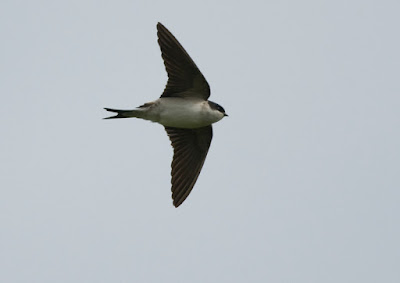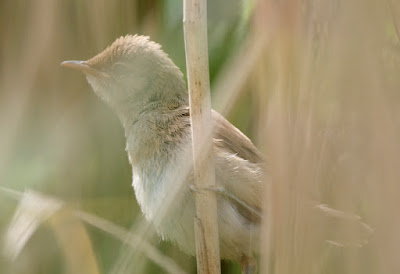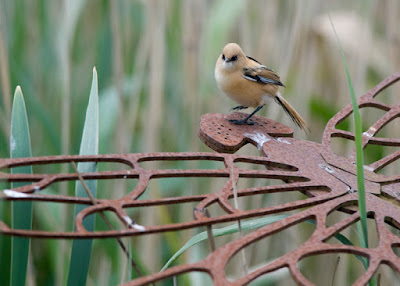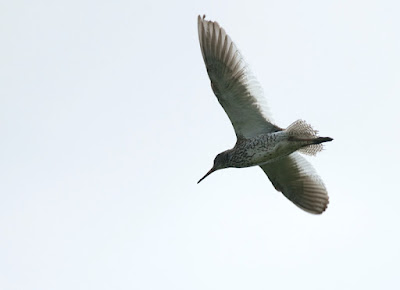Here are some of the successful Swift shots. Many more were failures.
Other fly-past things included a lone Common Tern, a few Shelducks heading river-wards, and a smattering of House Martins. For the record, there were also a few Swallows about but I didn't get any pics of them.
Also along the riverside was this Whitethroat, taking a break from song-flighting.
We decided to walk round anticlockwise. This Whitethroat and Sedgie were both right by the Purfleet hide.
From the hide itself there was not a lot to see, though inside it was a great exhibition - very detailed insect and other invert illustrations by Carim Nahaboo. Have a look here if you'd like to see examples.
At the MDZ, the Kingfishers were not home (as usual, in my experience) but we did find this stumpy-tailed little Reed Warbler fledgling, just about discernable through a wall of reed.
At the far end, sky-scanning produced no Hobbies, while loitering at the Dragonfly Pools produced some pings from deep in the windswept reeds but no Bearded Tits. The Redshanks were still much in evidence, as were Lapwings and Skylarks.
Over the Target Pools (which are, incidentally, looking very dried out at the moment) wheeled this Common Buzzard, first and as it turned out only raptor of the day.
Meanwhile, these two Linnet juvs sat on the railing by the Tower hide.
From the Tower hide were the usual mass of common waterfowl, with the usual bad lighting. I looked out of the left-hand side window in hope of seeing the Linnets again but instead found this Wren, collecting feathers for its nest.
The return walk wasn't terribly exciting. I include this pic of a Cormorant because it shows quite a wide Rainham view that's miraculously free of tower blocks, pylons and flyovers.
We checked all the ditches and dykes for Water Voles but found none. There were plenty of Coot families with various-aged young. It's a bit grim but Coots practice brood reduction, killing off some of their own chicks at a very early stage, so a brood of six or seven tiny Cootlets usually becomes a brood of four or fewer adolescents like this. This chick was one of two, each being looked after by one of its parents, and I must say that the constant whining cries the chicks were making was quite annoying enough with just the two of them.
Quite near the woodland, Shane found our one and only Common Lizard of the day. It must have been quite chilled (in both senses of the word) as it put up with us lying down close to it for photos.
On into the woods and we saw very little here, even the Cordite store had scant insect life in evidence. It was now about noon and the cloud was at its thickest.
About the only thing that caused me to raise my camera here was a pair of Collared Doves, looking the picture of togetherness atop a photogenic ivy-covered stump.
A Robin, carrying food for its chicks, landed on the railing of the visitor centre ramp as we walked up, and posed with all the poise and confidence that befits the newly crowned National Bird of the UK.
We had tea at the visitor centre and set off again to walk down to the Dragonfly Pools in the hope of finding the Beardies - and the sun began to come out.
A Magpie enjoying the sunny spell from the ramp up to the visitor centre.
A male House Sparrow enjoying a dust-bath on the path just before Purfleet hide. It's an odd thing about the Rainham sparrows - despite the constant human activity around their preferred spot near the visitor centre, and the availability of crumbs from the picnic tables, they are quite nervy and won't allow close approach.
By the Purfleet hide, we found this Little Grebe with its (very little) little ones.
A closer view of one of the little fluffkins. It would have fitted neatly into a tablespoon.
The family swam under the boardwalk bridge and I took this shot of one of the babes from above. It (the photo) is flawed in many ways but I like the water swirls, the droplets, and the tabby-cat pattern on the chick's back.
We went into the MDZ again, and for the first time (for me anyway) got lucky - the male Kingfisher was sitting on view (sort of). The people already present kindly pointed out the best gap in the mesh to peer through, in order to see the bird sitting quietly on a very low perch. The pair's last brood fledged about a week or so and they are currently cleaning out all the crap and fish bits from the nest hole ready to start the next brood.
A little further on, more baby-making - a Moorhen sitting tight on her nest close to the boardwalk.
Carrying on to the Dragonfly Pools, our luck held - two juvenile Beardies soon appeared on one of the metal dragonfly sculptures and struck a few poses. They must have been glad of something to sit on which wasn't being thrashed about by the wind.
In between Beardie shots I photographed this Woodpigeon on the 2 of the shooting range numbers (there were also Woodies on 6 and 7 but those lacked the pretty foreground yellowness of 2).
The Redshanks were also making themselves noticed here, flying about and calling a lot, and attempting (unsuccessfully) to perch on the narrow wire on top of the Fox-proof fence.
All the signs are that both Redshanks and Lapwings are having a pretty good breeding season here.
We headed back after that, via the reserve rather than the riverside, and exited though the lower turnstile rather than the visitor centre. This enabled us to take a look at the swarm of Honey-bees which have moved in here.







































2 comments:
Crikey, what a busy day, loadsa photo's!
Excellent set, looks like a very productive day.
Post a Comment